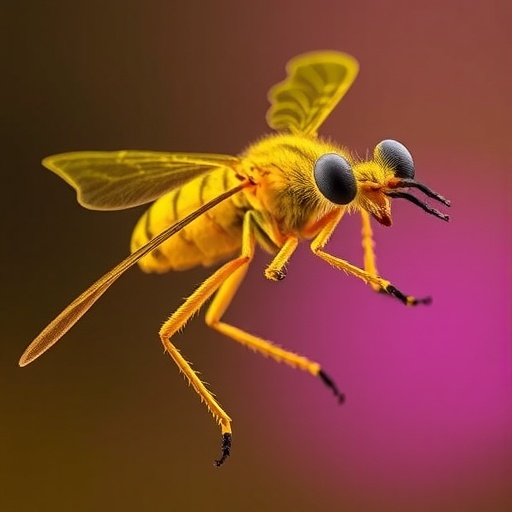
In a groundbreaking study published in Nature Microbiology, researchers have uncovered the molecular underpinnings that enable the yellow fever 17D vaccine strain to be both highly effective and unusually safe. Through meticulous molecular analyses, Zhang, Chavez, Winkler, and their colleagues have pinpointed specific amino acid substitutions in just two viral proteins that are responsible for the attenuation – or weakening – of the virus within this vaccine widely used globally. This revelation not only deepens our understanding of flavivirus biology but also paves the way for improved vaccine design against yellow fever and potentially other viral pathogens.
Yellow fever, caused by a flavivirus transmitted primarily by mosquitoes, has plagued humanity for centuries with periodic outbreaks resulting in high mortality. The yellow fever 17D vaccine, introduced in the 1930s, revolutionized control efforts by providing a live-attenuated virus capable of eliciting robust and durable immunity after a single dose. Despite its remarkable track record, the precise genetic basis for the attenuation observed in 17D has remained elusive. This new study offers definitive molecular insights by identifying two key proteins whose altered amino acid sequences correlate directly with the loss of virulence.
The researchers began by comparing the genomic sequences of the wild-type yellow fever virus and the 17D vaccine strain. Their bioinformatic analyses flagged a small subset of amino acid differences scattered throughout the viral proteome. Yet, functional investigations singled out changes localized to two nonstructural proteins, which play critical roles in viral replication and host interaction. These proteins, designated NS2A and NS4B, have been implicated in the virus’s ability to antagonize host immune responses and replicate efficiently within human cells.
.adsslot_auiJD43sPS{ width:728px !important; height:90px !important; }
@media (max-width:1199px) { .adsslot_auiJD43sPS{ width:468px !important; height:60px !important; } }
@media (max-width:767px) { .adsslot_auiJD43sPS{ width:320px !important; height:50px !important; } }
ADVERTISEMENT
To validate their hypotheses, the team employed reverse genetics to systematically swap the amino acid sequences between the vaccine strain and the wild-type virus in cultured cells. Restoring wild-type residues in NS2A and NS4B during these experiments led to a resurgence of viral replication capacity and enhanced ability to suppress interferon signaling, a key component of innate immunity. Conversely, introducing vaccine-specific mutations into the wild-type background reduced viral fitness and improved host antiviral responses. These mechanistic studies definitively demonstrated causal roles for these amino acid changes in viral attenuation.
Further biochemical assays revealed that the altered residues in NS2A and NS4B compromise critical protein-protein interactions necessary for efficient formation of the viral replication complex. This disruption likely impairs viral RNA synthesis and assembly within host cells, fundamentally limiting replication and spread. Moreover, these mutations affected the ability of NS4B to inhibit the STAT1 signaling pathway, enabling a more vigorous interferon-mediated antiviral state in infected cells. Together, these dual impacts underscore multifactorial mechanisms by which the 17D strain achieves safe attenuation.
From an evolutionary perspective, it is remarkable that such a small number of amino acid substitutions can so profoundly alter viral pathogenicity. The yellow fever virus genome consists of over 10,000 nucleotides encoding a polyprotein cleaved into multiple structural and nonstructural components. Having only two proteins harbor critical, function-altering mutations suggests a finely tuned balance between maintaining immunogenicity and limiting pathogenicity in the vaccine strain. This delicate equilibrium likely accounts for why 17D is both immunogenic and remarkably safe for millions worldwide.
Beyond yellow fever, these findings have broad implications for live-attenuated vaccine development. Attenuation through targeted, characterized amino acid substitutions in replication machinery proteins may represent a generalizable strategy for flaviviruses and other RNA viruses. Such precise molecular modifications can be reliably engineered using reverse genetics, expediting rational vaccine design. Furthermore, understanding host-virus protein interaction disruptions enhances our ability to predict viral attenuation phenotypes and safety profiles computationally.
The study also brings into focus the importance of NS proteins as multifunctional mediators of viral fitness and immune evasion. While much traditional vaccine research has concentrated on structural proteins such as the envelope, this work highlights the pivotal contributions of nonstructural components in shaping viral phenotypes. Targeting these often-overlooked proteins for genetic attenuation thus emerges as a fertile avenue for next-generation vaccine platforms.
Technical advances in deep sequencing, structural biology, and molecular virology were instrumental in enabling these discoveries. High-throughput sequencing facilitated precise comparisons between viral strains, while structural modeling illuminated how amino acid substitutions alter protein folding and interactions with host factors. Complementary immunological assays quantified how these molecular changes translated into altered antiviral signaling dynamics within human cells, providing a holistic understanding from molecule to immune response.
Importantly, this research also informs the ongoing monitoring of vaccine strain stability and safety. Identifying and cataloging critical amino acid residues responsible for attenuation enables regulatory agencies and manufacturers to surveil genetic drift during vaccine production and storage. Maintaining these substitutions is paramount to preserving vaccine efficacy and preventing reversion to virulence, which, although exceedingly rare, represents a theoretical risk in live-attenuated vaccines.
The practical ramifications for global public health are significant. The yellow fever 17D vaccine remains the cornerstone of prevention for endemic regions in sub-Saharan Africa and South America, where yellow fever poses periodic epidemic threats. Insights from this study empower scientists to refine this vaccine further or develop enhanced variants with improved immunogenic profiles or stability under varied climatic conditions. Additionally, the principles elucidated here could expedite vaccine development for emerging flaviviruses such as Zika, dengue, and West Nile virus, all of which share genetic and functional similarities.
Moreover, the molecular elucidation lends itself to rational design of antiviral drugs targeting NS2A and NS4B functions. Therapeutics that mimic the attenuation effects discovered here could potentially weaken replication of wild-type yellow fever or related flaviviruses during outbreaks, complementing vaccines. Such dual-use strategies integrating vaccines and antivirals form part of comprehensive preparedness planning against viral hemorrhagic fevers.
This work epitomizes the synergy between classical virology and cutting-edge molecular techniques driving modern vaccinology. Nearly a century after the 17D vaccine’s inception, these findings show how foundational vaccines nevertheless hold secrets unlocked only by contemporary science. The study by Zhang and colleagues represents a paradigm shift toward prescriptive, mechanistic understanding of attenuation, illuminating a path forward for safer, more effective vaccines rooted in molecular precision.
As global health agencies strive to eliminate yellow fever’s threat, harnessing such detailed mechanistic insights accelerates innovation and practical application. Recognition of precisely which amino acids dictate virulence or attenuation equips researchers to respond nimbly to viral evolution and emerging strains. In an era punctuated by pandemic threats, this level of molecular clarity is invaluable for maintaining vaccination as humanity’s frontline defense.
In conclusion, the identification of key amino acid changes within NS2A and NS4B responsible for attenuation of the yellow fever 17D vaccine strain represents a milestone in molecular virology and vaccinology. By illuminating how subtle modifications cripple viral replication and enhance immune detection, this research not only explains the longstanding success of 17D but also charts a course for next-generation vaccines and antiviral strategies. The future of flavivirus control and prevention looks brighter with such detailed molecular maps steering scientific innovation.
Subject of Research: Molecular basis of attenuation in the yellow fever 17D vaccine strain, focusing on amino acid changes in viral proteins NS2A and NS4B.
Article Title: Amino acid changes in two viral proteins drive attenuation of the yellow fever 17D vaccine.
Article References:
Zhang, J., Chavez, E.C., Winkler, M. et al. Amino acid changes in two viral proteins drive attenuation of the yellow fever 17D vaccine. Nat Microbiol (2025).
Image Credits: AI Generated
Tags: amino acid substitutions in viral proteinsflavivirus biology and immunologygenetic basis of vaccine safetyhistorical impact of yellow fever vaccineinsights into viral virulence losslive-attenuated virus technologymolecular analysis of flavivirusmosquito-borne diseases and vaccinesrobust immunity after vaccinationvaccine design for viral pathogensyellow fever 17D vaccine effectivenessyellow fever vaccine attenuation






No Comments
Leave a comment Cancel